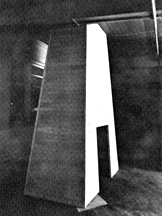- MAIN INDEX | ARTIST INDEX
| August 12 - 30, 1980 Robert Wiens
| |
 Robert Wiens, detail from "Site Constructions", 1980. invitation image 18K | |
PRESS RELEASE Robert Wiens, a Toronto artist, will have his first major solo-exhibition at MERCER UNION August 12 to 30th. The constructions done specifically for the gallery will be large scale requiring a week's on-site labour previous to the opening date. The installation consists of six parts: two truncated pyramid structures extending floor to ceiling based on the golden-section, and four related works done directly on the floor and wall using circular and spiral motifs.
Robert Wiens
Martha Fleming Robert Wiens' installation is a site specific work which attempts to locate the space and, moreover, to identify the artist within it through a carefully balanced association of elements. Wiens removed a wall for his installation revealing a central pillar in the fundamentally square gallery. From this pillar run four almost indiscernible troughs in the concrete floor which subtly divide the room into four equal parts. The north quadrants each 'house' a floor to ceiling wood and plaster hut whose open doors face two large circles painted on the opposing walls. Mediating the line which divides the two southern quad rants is a compass-like circle with a long triangular metal bar straddling the line itself. Of course, the central pillar and the lines which radiate from it contribute to the sense of definition-by-correlation. But is is how Wiens has chosen to correspond with these designations that gives his work a kind of pre-catalytic grace. This state is closer to Bachelard's phenominological notion of definition-by-being-there than it is to definition-by-correlation. The huts and the painted circles oppose one another in a locative rather than an aggressive way. The stasis of objects in their relation to one another is descriptive in the sense of exposing and defining the perimeters of the gallery itself. The objects are proportioned in such a way as to, through their association, delimit the space they occupy and place their author within it. Wiens' "self-positioning" effected in a number of ways. His extensive use of geometry (in particular Pythagorean theories of proportion) is central to the construction of the piece. The elements occupy four separate 'quarters' of the divided space. But by using design devices such as the golden section rectangle, Wiens has brought a natural relation to objects already in opposition to each other. Into the balanced juxtapositions he has also introduced mirror ratios of his own body. Most significantly the bar of the compass which navigates the divided floor and presents the possibility of a variable is as long as Wiens tall, and weighs what he weighs. Similarly, his references to pre-Spanish invasion cave cities in southern United States are tools understand and experience of location. Inherent in these cave cities carved out of sheer rock is the specificity of place and the determinism of shaping one's own surroundings to exemplify identity. For Wiens they were still, abandoned, perfect registers of the relation of individuals to their surroundings, though the individual no longer remained. Using the fundamental shapes of these buildings (rectangular for living and circular for ritual practice) he hoped to evidence this dormant associative perfection. But the tools of this explanation are not to be confused with what they explain. Wiens' installation more than a study in geometry nor does it depend on a knowledge Amer-lndian architecture. Its success and its unity, rather, is such that a visitor feels intrusive. The gallery is full, and Wiens is present in it.
| |